|
|
| The Chausath Yoginis Temple of Hirapur |
|
| A beautiful example of sculptural art in Orissa |
|
To reach the small village of Hirapur we travelled along the ancient road that from Bhubaneswar leads to Puri crossing the beautiful Orissan countryside. Soon after the village our driver stopped nearby a water pool with a small temple in the middle. Inside a gardened area protected by a fence lies the mysterious Sixty-four Yoginis Temple (Chaunsathi Yoginis) (xi c.) As soon as we entered the fence we noticed, nearby a white small Shiva temple, an interesting old black slab with the image of Krishna as the divine flute player (‘venu gopala’).
The Yoginis Temple is a simple circular sandstone enclosure open to the sky (hypaethral) permitting the fierce Orissan sun to pour into its exposed madapa and the open arena.
Sixty-Four Yoginis Temple |
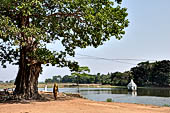
|
The mysterious cult of the yoginis (literally possessors of the yoga) is one of the various expressions of the esoteric Tantric sects that flourished in Orissa about 8th century A.D. Worshipped for their ability to aid the devotee, often a king, in attaining worldly power and success, the cult of yoginis has its origins in the tribal / folk culture. Since the circle of stones of prehistoric times, tribal people of the forest used to offer sacrifices to a so-called ‘circle of the goddess’ (devicakra) associated with fertility rites. Still today the favoured deities in the Orissan villages are female deity like Shyamakali, Ramachandi, Harachandi, Mangala etc., presiding over the welfare of the village.
Images of cluster of goddesses known as the seven mothers (saptamatrikas) are found on Shiva temples since the earliest times. The number seven is in direct relation to the stars of the Pleiades constellation. In later temples the saptamatrikas are replaced by the eight Great Goddesses (asta matrikas). When are grouped together the matrikas are also called yoginis.
Puranic texts refer to the Yoginis as blood-thirsty flesh-eating demonesses like the matrikas which helped Devi to slay the demon, myth that is reflected in the Orissan Goddess Durga killing the buffalo-demon with the help of female soldiers called Yoginis.
Tantric rituals elevated these local deities from the horrifying flesh-eating demonesses who haunt the charnel grounds into beautiful spiritual guides who could bestow magical/alchemical powers. Tantric Yoginis are associated with Bhairava the terrible form of Shiva. In his eightfold manifestation the god is the guardian of the spatial directions presiding, either alone or paired as consort with the eight mother goddesses, over the sacred space. Each of the eight Bhairavas is chief of seven other Bhairavas, all together sixty-four of whom are the companions of the sixty-four yoginis.
Hypaethral Yoginis temples were likely used by early tantric sects like the Pasupatas and Kapalikas that worshipped the Yoginis in cakra (circle) and are associated with rituals of the left hand path (Vamacara) where the worship is performed by the husband-wife couple (maihtuna).
|
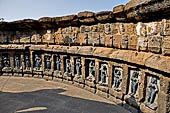
|
Sixty-Four Yoginis Temple
|
Orissa has the fortune to posses two of these outstanding temples and the one of Hirapur is surely the best preserved. The architecture of this hypaethral shrine is simple, the temple entrance faces East with in front a large stone platform, a clear association with rituals related to the worship of the sun.
On the outer face of the enclosure wall there are nine Katyayanis. Images of such female deities are rare in Orissa, Katyayani is the name in which Durga is known in Orissa. Here they are represented as two-armed female figures standing on the trunkless head of the Demon with skull cup and dagger in their hands with jackal and dog and an attendant holding a royal umbrella. On the sides of the entrance there are two dvarapalas, inside the low vestibule that leads to the enclosure there are two male images with emaciated body and sunken belly wearing garlands of skulls.
The vestibule widens into an open circle encircling a rectangular chandi mandapa.
Sixty-Four Yoginis Temple |
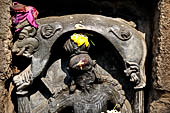
|
The inner face of the enclosure wall contains 60 equidistantly spaced niches containing exquisite dark chlorite statues of the yoginis, the other four images are in niches of the mandapa (one is missing). The ten armed yogini of the 31st niche hidden below drapes and flowers is worshipped as Mahamaya the presiding deity of the temple.
In miniature shrine like niches of the chandi-mandapa there are four Bhairava images: Ekapada Bhairava (with one leg only), the Mercurial Svacchandaraja and Chanda with a similar iconography: ten-armed male figures holding damaru and skull cup and seated in Padmasana (royal ease) on a corpse (Pretapadmasanastha) and with erect phallus (urdhalinga) symbol of sexual abstention.
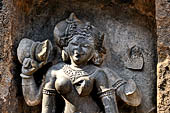
|
Sixty-Four Yoginis Temple
|
The Yoginis images are sculpted in exquisitely classical medieval Orissan style, stylistic coeval of Mukteshwar Temple of Bhubaneswar. All are shown standing in a variety of postures and associated with their vehicle (vahana), a mouse, a crow, a crab, corpse, elephant, flower, human head, snake, tortoise, wheel etc. Each image is extraordinary beautiful portrayed with exquisite hairdos tied into elaborate chignons, sensual voluptuous bodies with jewelled ornaments on their hips. Their facial expressions are gentle, often with alluring smiles. A large numbers have animals heads such as those of an elephant, a wild boar etc. Some of them wears the tiara (mukuta) signifying their semi divinity status.
The names of the yoginis are uncertain and also their iconography does not show uniformity and none of them can be considered the female counterpart (shakti) of a male god. Anyhow we can identify Ganga and Yamuna the two sacred rivers, fearsome Chamunda, the four-armed goddess mounted on a jackal, with a tiger skin and a garland of skulls, she holds a severed head in her lower left hand.
Before leaving the temple we could not avoid to note a wooden structure with thatched roof dedicated to village rituals.
Sixty-Four Yoginis Temple |
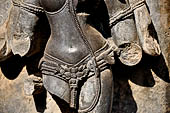
|
|
&Nbsp; Related Pages
-
-
-
|
|
|
 |
|



